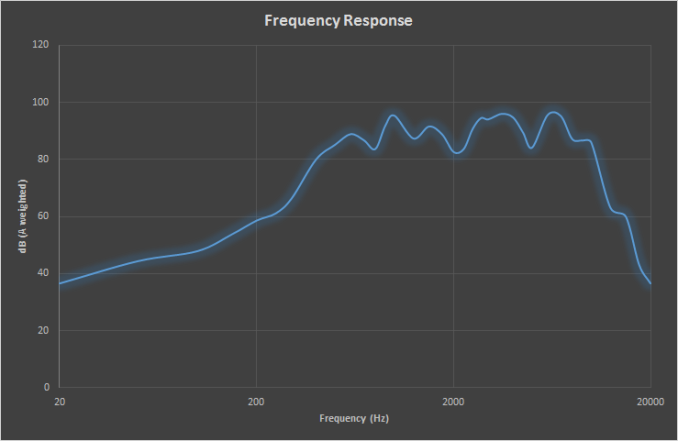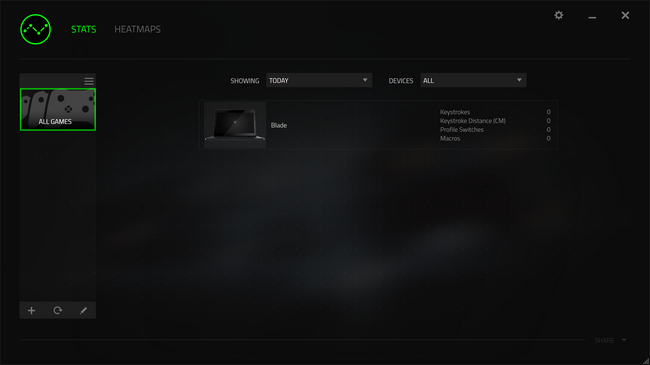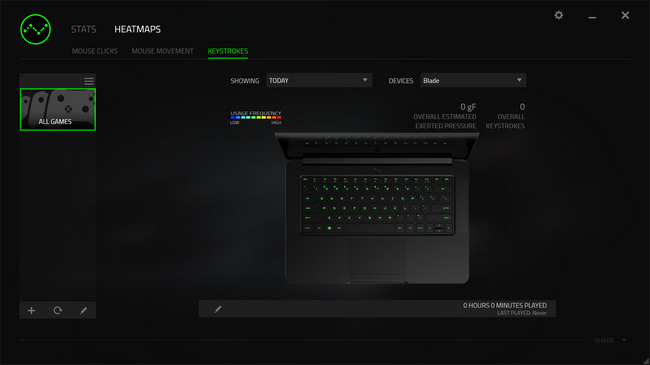The 2015 Razer Blade Review
by Brett Howse on February 11, 2015 2:00 PM EST- Posted in
- Laptops
- Razer
- Razer Blade
- Notebooks
- GTX970M
Speakers
The Razer has two front facing stereo speakers. With laptops this thin, there generally is not a lot of room for good sounding speakers, but I am ready to be surprised at any time. As for overall volume, the new Razer Blade comes in at 83 dBA. The 2014 Razer Blade did not impress me with its speaker quaility, which was disappointing due to not only the cost of the device, but the front facing speakers, which should have an advantage over any system which fires the speakers down, were very poor. With laptops getting as thin and small as they are now, forward facing speakers are less common, so I was looking for more on the 2014 model.
The frequency response for the 2015 Razer Blade is very much improved over the last model. The 2014 model had a very poor curve, and almost no sound at all under 200 Hz. As soon as the first frequency was tested it was obvious that some changes have been made to the speakers. I reached out to Razer, and asked them about the speakers. Although the actual speakers are the same, various subsystems have been changed. Some tuning has certainly been done to improve the overall sound quality, and it has made a big difference. When gaming, headphones will still be necessary to get rid of the fan noise, but for watching movies or listening to music, the speakers are much more usable now.
Software
The only software installed on the system, is Razer’s Synapse software. This in and of itself is worth mentioning due to the huge amount of extra software normally installed on new PCs. On a premium device such as this, it is nice to see that there are no bundled extras to increase Razer's margins. The Synapse software is their in-house software to control the Blade and other Razer peripherals. Razer Synapse has continued to evolve since we last took a look at it. We will not go over what has not changed, so if you want to check that out, it is detailed on our last review here. What is new is a new Stats option on the Synapse software. Opening this goes to some interesting software which lets you keep track of what you are doing while gaming.
Stats, once enabled, will keep track of total keystrokes, distance, profile switches, and macro use, to let you know just what it is you are doing in the heat of battle. And speaking of heat, moving over to the Heatmaps section displays some very cool graphics of where your mouse clicks occur on the screen, where you tend to move your mouse to, and what keys you use the most while gaming. Some of us are certainly not good enough gamers to gain any sort of insight with this data, but it is interesting to look at. For those that want the extra edge, it is a nice addition to the software.
This is what is new on the software, but no software is perfect, nor is any hardware. In future versions of the Synapse software, it would be nice to see some extra features that are missing from the Razer Blade.
First, and previously mentioned, is the lack of any sort of customization of the lighting scheme for the Razer Blade. The green is nice, but there are those of us who like to really make it our own. Alienware has done this for years, and Razer now has some nice looking RGB keyboards which offer some great customization and effects.
The other addition to the software is likely more functional. Fan control should be part of the Synapse software suite on laptops. As much as we like how silent the Razer Blade is doing light duty tasks, almost nothing is more annoying to some people than a fan that ramps up and down, rather than just stay constant. A nice addition would be multiple fan settings, which could be automatically enabled when the GPU kicks in. As we saw in the GPU load graph, there was no throttling at all on the GPU, but the temperature would go up and down like a saw blade. Give me an option to just leave the fans on maximum in that scenario.















116 Comments
View All Comments
tipoo - Thursday, February 12, 2015 - link
I'm guessing it would be the same as the internal display - the discreet GPU just poops its output into the integrated GPUs memory so it can be output to the monitor, which only has one physical connection to the internal GPU.voicequal - Thursday, February 12, 2015 - link
This would be great for my application, except the Intel mobile chipsets don't support the number of devices I need from the USB3 controller. You'd be lucky to get more than 10 external devices working off the xHCI controller before the dreaded Not enough USB controller resources error. http://answers.microsoft.com/en-us/surface/forum/s...For what it's worth, I find DisplayPort preferable over HDMI because DP is more flexible for splitting to multiple monitors.
DanNeely - Thursday, February 12, 2015 - link
The accepted answers on that link cite the problem as one of maximum power the port can put out; just because the port can address 127 devices doesn't mean it can provide them all with power. Non-charging USB3 ports are limited to 0.9 amps of 5v current; which ports (if any) get extra power for charging stuff is upto the motherboard OEM to decide if they want to provide extra power to it or not.voicequal - Thursday, February 12, 2015 - link
Unfortunately the accepted answer on that thread isn't the issue. The error is due to the limited number of USB devices/endpoints supported by the Intel xHCI controller. I'm curious if more devices are supported on the Broadwell chipsets, but don't have one to test yet.ruthan - Thursday, February 12, 2015 - link
I dont believe whole conclusion.. if this is truth:" When the fans are running though, the laptop is very loud. We measured 55.0 dBA at 1 inch from the system after one hour of gaming. It is very loud, and very noticeable. In my opinion, any gaming on the Razer Blade would necessitate headphones.."
For me it means that whole laptop design failed - too much hoursepower for cooling system, good experience and performance only on paper or for deaf people..
TheinsanegamerN - Tuesday, February 17, 2015 - link
agreed. They should have stuck with the 37 watt i7 and put the 965m in instead.ingwe - Thursday, February 12, 2015 - link
This looks so great. I wish they would have actually gone with a lower power CPU to get better battery life. I also wish that there would be DP in addition to HDMI. These are relatively minor gripes. Now to come up with $2700 for this...HiTechObsessed - Thursday, February 12, 2015 - link
Again, why don't y'all ever look at Sager laptops? The Sager NP8651 is less than an inch thick, packs a dual-fan-cooled 970m, the same quad-core i7 CPU, but has a starting price of $1,225 as opposed to $2k. Essentially, the Sager offers the same performance, while only spending a little over 60%?Even when adding an SSD to the Sager and Windows, you're still substantially cheaper.
awlllwa - Thursday, February 12, 2015 - link
I have had my NP8652 (980m model) for about a month now and it is awesome. All said an done, the same price as this here Razer, but with a 4k Sharp screen, 2x 512gb SSDs, 1tb HDD, and the chaise is not that thick. Like .2-.3" more, for way better internals, and I still have one more m.2 slot and 2 empty sodimm slots.I did strongly consider the 2014 Blade, but couldn't swallow the 870m for that price, this new one feels much of the same.
DanNeely - Thursday, February 12, 2015 - link
Because neither Sager, nor anyone who rebadges Sager laptops and sells them under their name is willing to send a review sample.